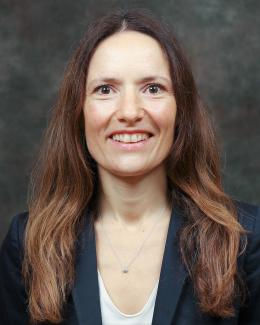ORNL Joint Faculty Flora Meilleur talks about the position she calls her “dream job”
March 18, 2015 — As a kid in the south of France, Flora Meilleur spent her days on mountainous farmland near the High Alps. A PhD and hemisphere-flip later she’s still surrounded by mountains, but she’s left the Alpine meadows for a career as a neutron scientist at the Department of Energy’s Oak Ridge National Laboratory and as a mentor for a new generation of researchers at North Carolina State University.
Meilleur is part of ORNL’s Joint Faculty Program, which encourages collaboration between ORNL and universities. She came to ORNL’s Neutron Sciences Directorate around ten years ago and played a leading role in the design and development of a new neutron beam line that she has used in her own research and that has attracted researchers from as far as Australia. She recalls those early times as “fun and exciting.”
“One of the first things I did in my job at ORNL was to secure funding from the National Science Foundation to build a neutron crystallography beam line at the High Flux Isotope Reactor,” Meilleur says. “Now we’re using this instrument to gain insight into enzyme function.”
In her research, which often concerns biomedical and bioenergy relevant proteins, structure can tell a lot. In medicine, for instance, a detailed understanding of enzymes can lead to the development of new therapeutics for disease. Using neutrons to analyze the biological specimens is key because neutrons reveal the position of hydrogen atoms in proteins—information that is difficult or impossible to get using other techniques.
In related research, Meilleur has worked with other NCSU faculty and used neutron beams to examine the structure of viruses in the virus family that causes diseases like dengue, yellow and West Nile fever. Her team looked at how the structure of viruses differs when they replicate in insect or mammalian host cells and found features unique to the virus when it was grown in a mammal.
But research rounds out just one side of Meilleur. She’s also interested in education and outreach.
“I’m a professor and I like teaching,” she says.
Each year, she runs a weeklong neutron scattering workshop at ORNL that introduces new students and faculty to scattering techniques. This year’s group will be the sixth class, and under Meilleur’s guidance the participants will tour the neutron facilities, attend lectures and take part in symposiums. The classes are kept small to create an intimate learning atmosphere.
“We try to keep a low student to teacher ratio to facilitate interaction with the staff at ORNL,” says Meilleur, adding, “It’s a good networking experience for students to meet students and researchers from outside their home institution.”
Another way in which Meilleur indulges her passion for education is at North Carolina State University, where she teaches graduate level courses in biochemistry and is a mentor to two graduate students.
While she says helping graduate students through their education and teaching in general are some of the most challenging things she has done, she says she enjoys it because it “pushes you to stay on top of everything and remain very open.”
“It’s very rewarding,” she says.
After juggling her responsibilities at ORNL and NC State and commuting back and forth between the two, Meilleur likes to hike with her family in the Smoky Mountains, play with her kids, eat “tasty” food and get her hands around a good French book.
While it’s a busy schedule, she says she has the best of both worlds and that everything together makes her joint ORNL-NC State position her “dream job.”
ORNL’s Joint Faculty Program has agreements with more than 40 universities and seeks to enhance scientific excellence and collaboration by engaging talented researchers across the partner institutions.
UT-Battelle manages ORNL for the Department of Energy's Office of Science. The Office of Science is the single largest supporter of basic research in the physical sciences in the United States, and is working to address some of the most pressing challenges of our time. For more information, please visit http://energy.gov/science/.


